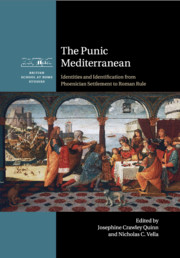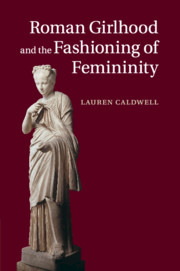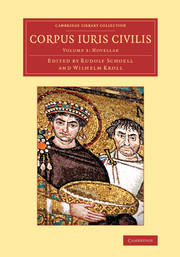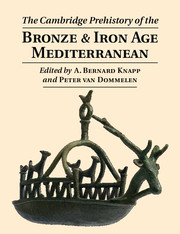Refine search
Actions for selected content:
23990 results in Ancient history
Review
-
- Book:
- Central Asia and Iran - Greeks, Parthians, Kushans and Sasanians
- Published by:
- Jagiellonian University Press
- Published online:
- 12 January 2018
- Print publication:
- 01 January 2015, pp 249-250
-
- Chapter
- Export citation
Crépuscule de l'Empire parthe – Les dernières drachmes
-
-
- Book:
- Central Asia and Iran - Greeks, Parthians, Kushans and Sasanians
- Published by:
- Jagiellonian University Press
- Published online:
- 12 January 2018
- Print publication:
- 01 January 2015, pp 155-158
-
- Chapter
- Export citation
Alexander the Great at Bactra: A Burning Question
-
-
- Book:
- Central Asia and Iran - Greeks, Parthians, Kushans and Sasanians
- Published by:
- Jagiellonian University Press
- Published online:
- 12 January 2018
- Print publication:
- 01 January 2015, pp 9-16
-
- Chapter
- Export citation
I Am Your Father! Dynasties and Dynastic Legitimacy on Pre-Islamic Coinage between Iran and Northwest India
-
-
- Book:
- Central Asia and Iran - Greeks, Parthians, Kushans and Sasanians
- Published by:
- Jagiellonian University Press
- Published online:
- 12 January 2018
- Print publication:
- 01 January 2015, pp 173-200
-
- Chapter
- Export citation
King Huviška, Yima, and the Bird: Observations on a Paradisiacal State
-
-
- Book:
- Central Asia and Iran - Greeks, Parthians, Kushans and Sasanians
- Published by:
- Jagiellonian University Press
- Published online:
- 12 January 2018
- Print publication:
- 01 January 2015, pp 107-114
-
- Chapter
- Export citation
Contents
-
- Book:
- Central Asia and Iran - Greeks, Parthians, Kushans and Sasanians
- Published by:
- Jagiellonian University Press
- Published online:
- 12 January 2018
- Print publication:
- 01 January 2015, pp 5-6
-
- Chapter
- Export citation
The Syriac Book of the Laws of the Countries, Eusebius’ Preparation for the Gospel, and the Clementine Recognitions: Early Witnesses for Christianity in Central Asia?
-
-
- Book:
- Central Asia and Iran - Greeks, Parthians, Kushans and Sasanians
- Published by:
- Jagiellonian University Press
- Published online:
- 12 January 2018
- Print publication:
- 01 January 2015, pp 159-172
-
- Chapter
- Export citation
Storehouses and Storage Practices in Old Nisa (Turkmenistan)
-
-
- Book:
- Central Asia and Iran - Greeks, Parthians, Kushans and Sasanians
- Published by:
- Jagiellonian University Press
- Published online:
- 12 January 2018
- Print publication:
- 01 January 2015, pp 115-142
-
- Chapter
- Export citation

Campus Martius
- The Field of Mars in the Life of Ancient Rome
-
- Published online:
- 18 December 2014
- Print publication:
- 19 January 2015

The Punic Mediterranean
- Identities and Identification from Phoenician Settlement to Roman Rule
-
- Published online:
- 18 December 2014
- Print publication:
- 04 December 2014

L'Astrologie grecque
-
- Published online:
- 18 December 2014
- Print publication:
- 22 May 2014

Roman Girlhood and the Fashioning of Femininity
-
- Published online:
- 18 December 2014
- Print publication:
- 15 December 2014

Corpus iuris civilis
-
- Published online:
- 18 December 2014
- Print publication:
- 17 April 2014

The Cambridge Prehistory of the Bronze and Iron Age Mediterranean
-
- Published online:
- 18 December 2014
- Print publication:
- 12 January 2015
Bibliography
-
- Book:
- Roman Girlhood and the Fashioning of Femininity
- Published online:
- 18 December 2014
- Print publication:
- 15 December 2014, pp 170-184
-
- Chapter
- Export citation
Epilogue
-
- Book:
- Roman Girlhood and the Fashioning of Femininity
- Published online:
- 18 December 2014
- Print publication:
- 15 December 2014, pp 166-169
-
- Chapter
- Export citation
Roman Girlhood and the Fashioning of Femininity - Title page
-
-
- Book:
- Roman Girlhood and the Fashioning of Femininity
- Published online:
- 18 December 2014
- Print publication:
- 15 December 2014, pp iii-iii
-
- Chapter
- Export citation
Copyright page
-
- Book:
- Roman Girlhood and the Fashioning of Femininity
- Published online:
- 18 December 2014
- Print publication:
- 15 December 2014, pp iv-iv
-
- Chapter
- Export citation
Chapter 4 - The pressure to marry
-
- Book:
- Roman Girlhood and the Fashioning of Femininity
- Published online:
- 18 December 2014
- Print publication:
- 15 December 2014, pp 105-133
-
- Chapter
- Export citation
Introduction
-
- Book:
- Roman Girlhood and the Fashioning of Femininity
- Published online:
- 18 December 2014
- Print publication:
- 15 December 2014, pp 1-14
-
- Chapter
- Export citation
